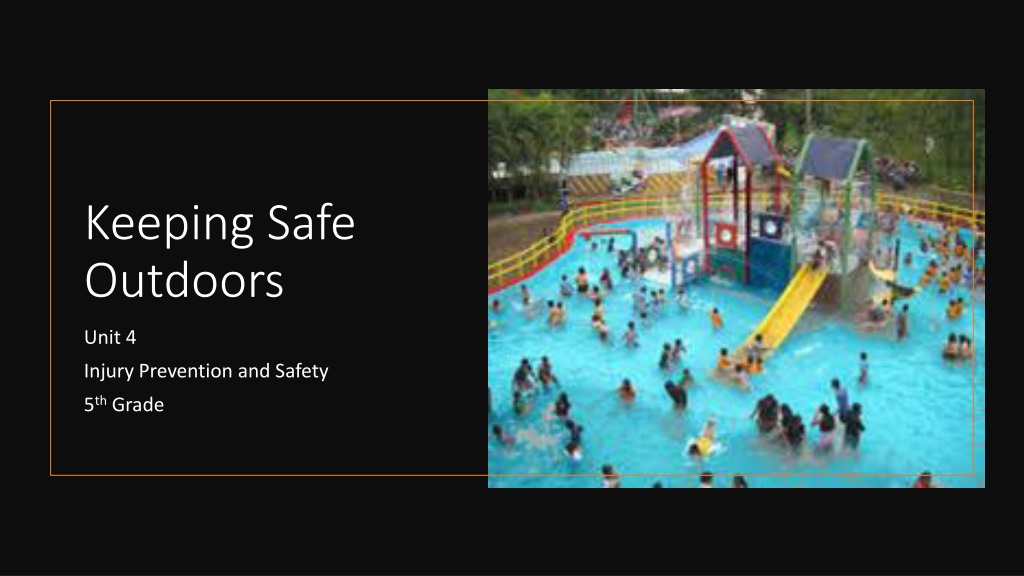Safety Tips for Outdoor Activities: Injury Prevention and Safety Guidelines
Explore safety guidelines for outdoor activities such as walking, cycling, and riding in cars to prevent injuries. Learn vocabulary related to pedestrian safety, seat belts, frostbite, and heatstroke. Follow rules for different weather conditions and water safety to ensure a safe outdoor experience.
Download Presentation

Please find below an Image/Link to download the presentation.
The content on the website is provided AS IS for your information and personal use only. It may not be sold, licensed, or shared on other websites without obtaining consent from the author. Download presentation by click this link. If you encounter any issues during the download, it is possible that the publisher has removed the file from their server.
E N D
Presentation Transcript
Keeping Safe Outdoors Unit 4 Injury Prevention and Safety 5thGrade
Learning Objectives Vocabulary Pedestrian Seat Belt Frostbite Heatstroke Describe safety precautions for walking, riding in cars, and using bicycles, scooters, or skateboards. List rules to follow during different weather conditions and in the water.
Do you like to spend time outdoors? DO you like to walk in your city or town? There are many fun things to do outside. There can also be dangers. Following safety rules, such as waiting at crosswalks, can help keep you safe as you enjoy these activities.
Walk Safely Walk Safely Have you ever walked to school or to a friend's house? A pedestrian is a person who walks on the sidewalk or in the street.
Use sidewalks and crosswalks Use sidewalks and crosswalks Don t enter the street between cars.
Obey Traffic Obey Traffic Signals Signals Wait for the Walk sign. Then look left, right, and left again before you cross.
Walk Facing Traffic if there are no sidewalks. This way you can see cars coming towards you. (my story)
Wear light-colored or reflective clothes if you are out at dusk or at night. This makes is easier for drivers to see you.
Walk with a friend or responsible adult. Don t hitchhike or take rides from any strangers. A stranger is a person you don t know. They might ask you for directions, find a lost pet. A responsible adult would ask another adult for help.
Seat Belt Seat Belt ALWAYS wear a seatbelt. It keeps you from being thrown out of a car in a crash. People 12 or younger should ride in the back seat. This way they will not be injured by the air bags. Air bags are designed to protect adults and they can hurt smaller people. Video Example Video
Riding on a bus Riding on a bus You should sit still, don t yell or fight. Be ready to get off when the bus is at your stop. Cross the street in front of the bus, not being it. Check to make sure the driver sees you before you cross.
Bikes, Skateboard, and Bikes, Skateboard, and Scooters Scooters All of these are fun to ride and great exercise. You should wear a helmet for all these activities. When riding a skateboard, roller skating, wear a helmet, elbow, and knee pads. Always ride on the path and avoid holes and bumps. Ride during the day. Wear bright colors so drivers can see you.
Hot Weather Hot Weather When you are outside in the hot weather, make sure you are wearing clothing that is loose, and protective. Stay out of the sun at midday. Wear sunglasses, sunscreen, and a hat. Drink lots of water. Heatstroke is harm to the body due to being exposed to high temperatures. Symptoms: hot dry skin, high body temperature. If you have these get into shade right away, get your body wet, and drink water to cool off.
Cold Weather Cold Weather Wearing several layers of clothing can help keep you warm. Gloves, hat, scarf, coat, shoes or boots that keep out water. Keep moving so your body will produce heat. Frostbite is an injury caused by extreme cold temperatures. Symptoms: Numbness, white, gray, or yellow skin. If you see any of these signs get into a warm room and get medical help right away.
In the water In the water Never swim alone: Swim with a buddy. Be sure there is a lifeguard or another responsible adult watching. If you have a problem while swimming, the adult can get help. Don t run or push other people: You can knock a person into the water who does not know how to swim. Never dive into any lake or river: Typically, you cannot always see what s in the water. It might be shallow or have other things like rocks and tree branches you could dive into.
If you see someone in trouble in water Call for help. Throw an object that floats, stick or rope, branch from a tree. Do not go into the water to try and save them by yourself. Instead get a lifeguard or have someone call 911.



























